gearbox SKODA FABIA 2003 1.G / 6Y User Guide
[x] Cancel search | Manufacturer: SKODA, Model Year: 2003, Model line: FABIA, Model: SKODA FABIA 2003 1.G / 6YPages: 233, PDF Size: 32.04 MB
Page 101 of 233
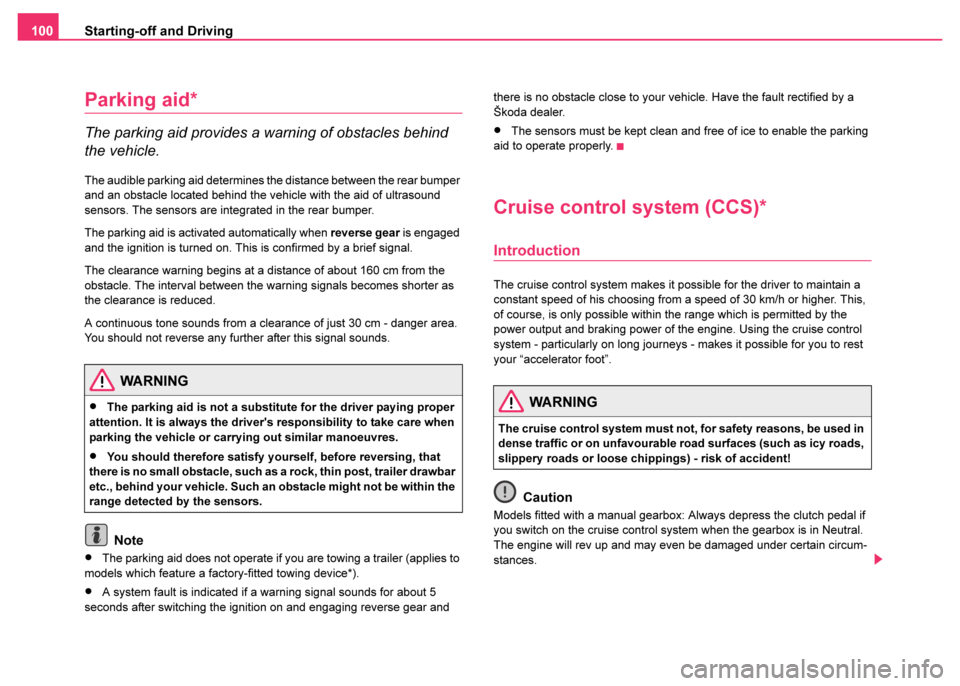
Starting-off and Driving
100
Parking aid*
The parking aid provides a warning of obstacles behind
the vehicle.
The audible parking aid determines the distance between the rear bumper
and an obstacle located behind the vehicle with the aid of ultrasound
sensors. The sensors are integrated in the rear bumper.
The parking aid is activated automatically when reverse gear is engaged
and the ignition is turned on. This is confirmed by a brief signal.
The clearance warning begins at a distance of about 160 cm from the
obstacle. The interval between the warning signals becomes shorter as
the clearance is reduced.
A continuous tone sounds from a clearance of just 30 cm - danger area.
You should not reverse any further after this signal sounds.
Note
•The parking aid does not operate if you are towing a trailer (applies to
models which feature a factory-fitted towing device*).
•A system fault is indicated if a warning signal sounds for about 5
seconds after switching the ignition on and engaging reverse gear and there is no obstacle close to your vehicle. Have the fault rectified by a
Škoda dealer.
•The sensors must be kept clean and free of ice to enable the parking
aid to operate properly.
Cruise control system (CCS)*
Introduction
The cruise control system makes it possible for the driver to maintain a
constant speed of his choosing from a speed of 30 km/h or higher. This,
of course, is only possible within the range which is permitted by the
power output and braking power of the engine. Using the cruise control
system - particularly on long journeys - makes it possible for you to rest
your “accelerator foot”.
Caution
Models fitted with a manual gearbox: Always depress the clutch pedal if
you switch on the cruise control system when the gearbox is in Neutral.
The engine will rev up and may even be damaged under certain circum-
stances.
WARNING
•The parking aid is not a substitute for the driver paying proper
attention. It is always the driver's responsibility to take care when
parking the vehicle or carrying out similar manoeuvres.
•You should therefore satisfy yourself, before reversing, that
there is no small obstacle, such as a rock, thin post, trailer drawbar
etc., behind your vehicle. Such an obstacle might not be within the
range detected by the sensors.
WARNING
The cruise control system must not, for safety reasons, be used in
dense traffic or on unfavourable road surfaces (such as icy roads,
slippery roads or loose chippings) - risk of accident!
Page 102 of 233
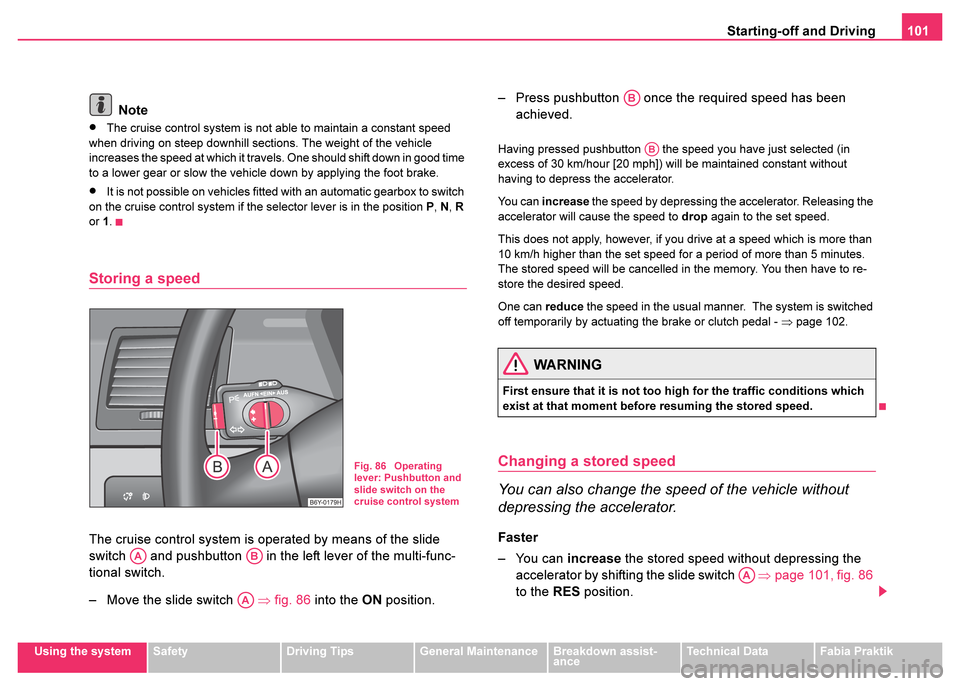
Starting-off and Driving101
Using the systemSafetyDriving TipsGeneral MaintenanceBreakdown assist-
anceTechnical DataFabia Praktik
Note
•The cruise control system is not able to maintain a constant speed
when driving on steep downhill sections. The weight of the vehicle
increases the speed at which it travels. One should shift down in good time
to a lower gear or slow the vehicle down by applying the foot brake.
•It is not possible on vehicles fitted with an automatic gearbox to switch
on the cruise control system if the selector lever is in the position P, N, R
or 1.
Storing a speed
The cruise control system is operated by means of the slide
switch and pushbutton in the left lever of the multi-func-
tional switch.
– Move the slide switch ⇒fig. 86 into the ON position. – Press pushbutton once the required speed has been
achieved.
Having pressed pushbutton the speed you have just selected (in
excess of 30 km/hour [20 mph]) will be maintained constant without
having to depress the accelerator.
You can increase the speed by depressing the accelerator. Releasing the
accelerator will cause the speed to drop again to the set speed.
This does not apply, however, if you drive at a speed which is more than
10 km/h higher than the set speed for a period of more than 5 minutes.
The stored speed will be cancelled in the memory. You then have to re-
store the desired speed.
One can reduce the speed in the usual manner. The system is switched
off temporarily by actuating the brake or clutch pedal - ⇒page 102.
Changing a stored speed
You can also change the speed of the vehicle without
depressing the accelerator.
Faster
– You can increase the stored speed without depressing the
accelerator by shifting the slide switch ⇒page 101, fig. 86
to the RES position.
Fig. 86 Operating
lever: Pushbutton and
slide switch on the
cruise control system
AAAB
AA
WARNING
First ensure that it is not too high for the traffic conditions which
exist at that moment before resuming the stored speed.
AB
AB
AA
Page 103 of 233
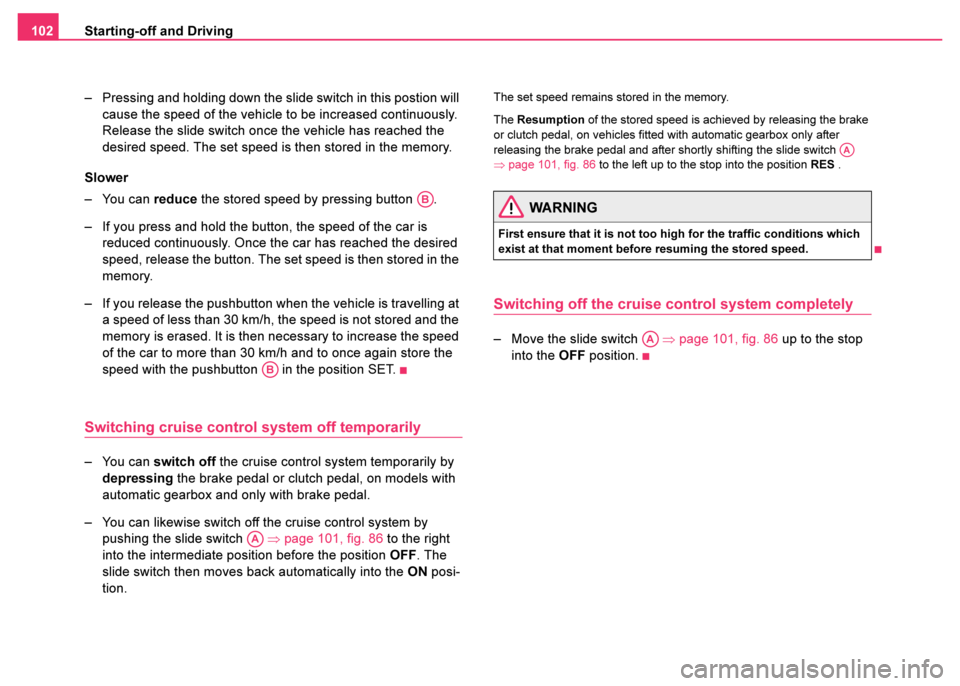
Starting-off and Driving
102
– Pressing and holding down the slide switch in this postion will cause the speed of the vehicle to be increased continuously.
Release the slide switch once the vehicle has reached the
desired speed. The set speed is then stored in the memory.
Slower
– You can reduce the stored speed by pressing button .
– If you press and hold the button, the speed of the car is reduced continuously. Once the car has reached the desired
speed, release the button. The set speed is then stored in the
memory.
– If you release the pus hbutton when the vehicle is travelling at
a speed of less than 30 km/h, the speed is not stored and the
memory is erased. It is then necessary to increase the speed
of the car to more than 30 km/h and to once again store the
speed with the pushbutton in the position SET.
Switching cruise control system off temporarily
– You can switch off the cruise control system temporarily by
depressing the brake pedal or clutch pedal, on models with
automatic gearbox and only with brake pedal.
– You can likewise switch off the cruise control system by pushing the slide switch ⇒page 101, fig. 86 to the right
into the intermediate position before the position OFF. The
slide switch then moves back automatically into the ON posi-
tion.
The set speed remains stored in the memory.
The Resumption of the stored speed is achieved by releasing the brake
or clutch pedal, on vehicles fitted with automatic gearbox only after
releasing the brake pedal and after shortly shifting the slide switch
⇒ page 101, fig. 86 to the left up to the stop into the position RES .
Switching off the cruise control system completely
– Move the slide switch ⇒page 101, fig. 86 up to the stop
into the OFF position.
AB
AB
AA
WARNING
First ensure that it is not too high for the traffic conditions which
exist at that moment before resuming the stored speed.
AA
AA
Page 104 of 233
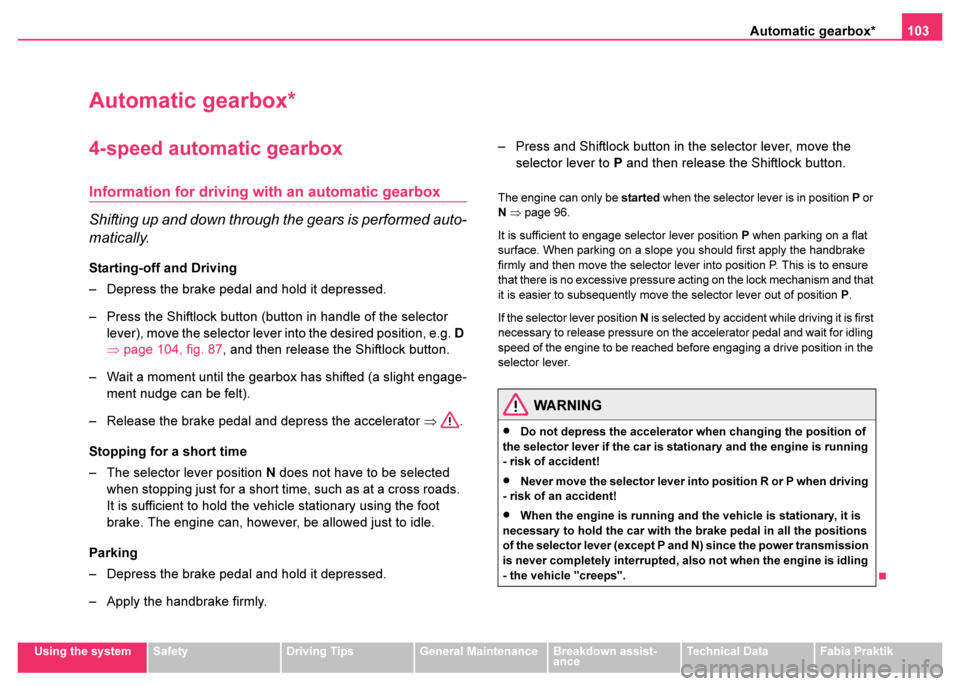
Automatic gearbox*103
Using the systemSafetyDriving TipsGeneral MaintenanceBreakdown assist-
anceTechnical DataFabia Praktik
Automatic gearbox*
4-speed automatic gearbox
Information for driving with an automatic gearbox
Shifting up and down through the gears is performed auto-
matically.
Starting-off and Driving
– Depress the brake pedal and hold it depressed.
– Press the Shiftlock button (button in handle of the selector
lever), move the selector lever into the desired position, e.g. D
⇒ page 104, fig. 87 , and then release the Shiftlock button.
– Wait a moment until the gearbox has shifted (a slight engage- ment nudge can be felt).
– Release the brake pedal and depress the accelerator ⇒.
Stopping for a short time
– The selector lever position N does not have to be selected
when stopping just for a short time, such as at a cross roads.
It is sufficient to hold the vehicle stationary using the foot
brake. The engine can, however, be allowed just to idle.
Parking
– Depress the brake pedal and hold it depressed.
– Apply the handbrake firmly. – Press and Shiftlock button in the selector lever, move the
selector lever to P and then release the Shiftlock button.
The engine can only be started when the selector lever is in position P or
N ⇒ page 96.
It is sufficient to engage selector lever position P when parking on a flat
surface. When parking on a slope you should first apply the handbrake
firmly and then move the selector lever into position P. This is to ensure
that there is no excessive pressure acting on the lock mechanism and that
it is easier to subsequently move the selector lever out of position P.
If the selector lever position N is selected by accident while driving it is first
necessary to release pressure on the accelerator pedal and wait for idling
speed of the engine to be reached before engaging a drive position in the
selector lever.
WARNING
•Do not depress the accelerator when changing the position of
the selector lever if the car is stationary and the engine is running
- risk of accident!
•Never move the selector lever into position R or P when driving
- risk of an accident!
•When the engine is running and the vehicle is stationary, it is
necessary to hold the car with the brake pedal in all the positions
of the selector lever (except P and N) since the power transmission
is never completely interrupted, also not when the engine is idling
- the vehicle "creeps".
Page 105 of 233
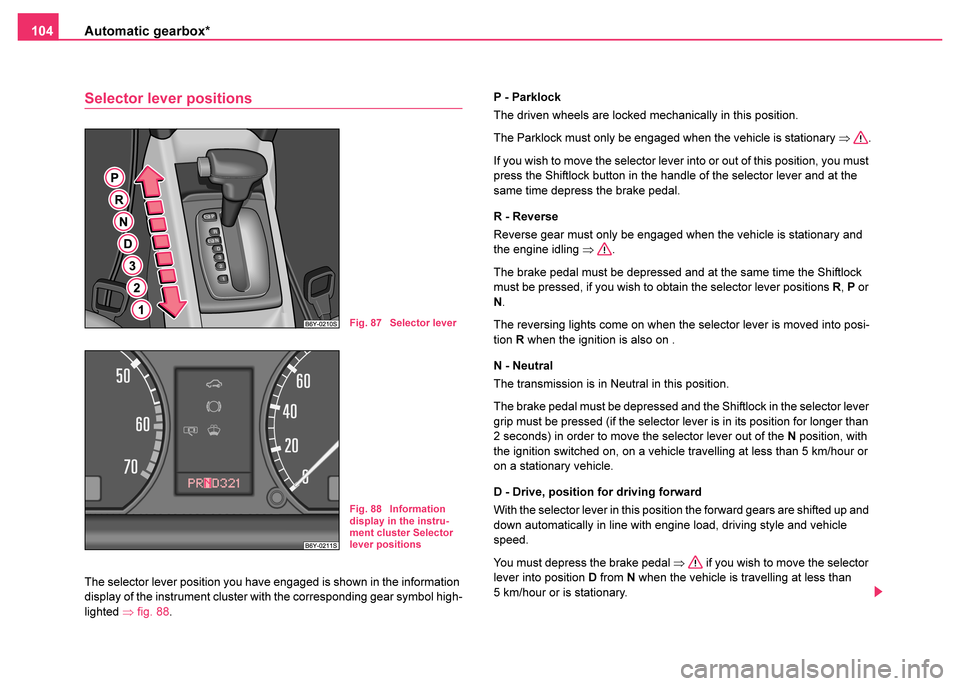
Automatic gearbox*
104
Selector lever positions
The selector lever position you have engaged is shown in the information
display of the instrument cluster with the corresponding gear symbol high-
lighted ⇒fig. 88. P - Parklock
The driven wheels are locked mechanically in this position.
The Parklock must only be engaged when the vehicle is stationary
⇒.
If you wish to move the selector lever into or out of this position, you must
press the Shiftlock button in the handle of the selector lever and at the
same time depress the brake pedal.
R - Reverse
Reverse gear must only be engaged when the vehicle is stationary and
the engine idling ⇒.
The brake pedal must be depressed and at the same time the Shiftlock
must be pressed, if you wish to obtain the selector lever positions R, P or
N.
The reversing lights come on when the selector lever is moved into posi-
tion R when the ignition is also on .
N - Neutral
The transmission is in Neutral in this position.
The brake pedal must be depressed and the Shiftlock in the selector lever
grip must be pressed (if the selector lever is in its position for longer than
2 seconds) in order to move the selector lever out of the N position, with
the ignition switched on, on a vehicle travelling at less than 5 km/hour or
on a stationary vehicle.
D - Drive, position for driving forward
With the selector lever in this position the forward gears are shifted up and
down automatically in line with engine load, driving style and vehicle
speed.
You must depress the brake pedal ⇒ if you wish to move the selector
lever into position D from N when the vehicle is travelling at less than
5 km/hour or is stationary.
Fig. 87 Selector lever
Fig. 88 Information
display in the instru-
ment cluster Selector
lever positions
Page 106 of 233
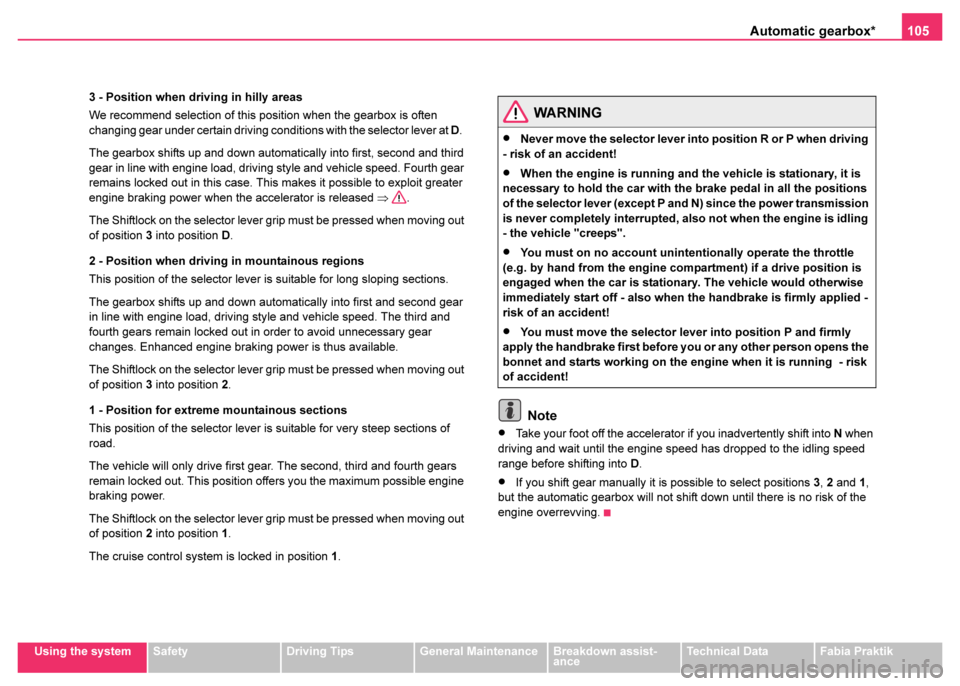
Automatic gearbox*105
Using the systemSafetyDriving TipsGeneral MaintenanceBreakdown assist-
anceTechnical DataFabia Praktik
3 - Position when driving in hilly areas
We recommend selection of this position when the gearbox is often
changing gear under certain driving conditions with the selector lever at D.
The gearbox shifts up and down automatically into first, second and third
gear in line with engine load, driving style and vehicle speed. Fourth gear
remains locked out in this case. This makes it possible to exploit greater
engine braking power when the accelerator is released
⇒.
The Shiftlock on the selector lever grip must be pressed when moving out
of position 3 into position D.
2 - Position when driving in mountainous regions
This position of the selector lever is suitable for long sloping sections.
The gearbox shifts up and down automatically into first and second gear
in line with engine load, driving style and vehicle speed. The third and
fourth gears remain locked out in order to avoid unnecessary gear
changes. Enhanced engine braking power is thus available.
The Shiftlock on the selector lever grip must be pressed when moving out
of position 3 into position 2.
1 - Position for extreme mountainous sections
This position of the selector lever is suitable for very steep sections of
road.
The vehicle will only drive first gear. The second, third and fourth gears
remain locked out. This position offers you the maximum possible engine
braking power.
The Shiftlock on the selector lever grip must be pressed when moving out
of position 2 into position 1.
The cruise control system is locked in position 1.
Note
•Take your foot off the accelerator if you inadvertently shift into N when
driving and wait until the engine speed has dropped to the idling speed
range before shifting into D.
•If you shift gear manually it is possible to select positions 3, 2 and 1 ,
but the automatic gearbox will not shift down until there is no risk of the
engine overrevving.
WARNING
•Never move the selector lever into position R or P when driving
- risk of an accident!
•When the engine is running and the vehicle is stationary, it is
necessary to hold the car with the brake pedal in all the positions
of the selector lever (except P and N) since the power transmission
is never completely interrupted, also not when the engine is idling
- the vehicle "creeps".
•You must on no account unintentionally operate the throttle
(e.g. by hand from the engine compartment) if a drive position is
engaged when the car is stationary. The vehicle would otherwise
immediately start off - also when the handbrake is firmly applied -
risk of an accident!
•You must move the selector lever into position P and firmly
apply the handbrake first before you or any other person opens the
bonnet and starts working on the engine when it is running - risk
of accident!
Page 107 of 233

Automatic gearbox*
106
Selector lever lock
Automatic selector lever lock
With the ignition on, the selector lever is locked when it is in the positions
P and N. You must depress the brake pedal first and press the Shiftlock
button at the same time in order to move the selector lever out of these
positions. The following will be displayed in the information display*:
P LOCKED
or
N LOCKED
Symbol
also lights up in the selector lever cover until the brake pedal
is actuated.
A time delay element ensures that the selector lever is not blocked when
rapidly switching over the position N (e.g. from R to D). This does, for
example, allow one to seesaw out a stuck vehicle. The selector lever lock
will click into place if the lever is in the N position for more than 2 seconds
without the brake pedal being pressed.
The selector lever lock is only active if the vehicle is stationary or moving
at speed of less than 5 km/hour. The lock is switched off automatically into
position N when the car is travelling at a higher speed.
Shiftlock button
The Shiftlock button in the handle of selector lever prevents certain
selector lever positions being engaged inadvertently. The selector lever
lock is cancelled when you press the Shiftlock button.
Kickdown function
The kickdown function provides you with maximum accel-
eration power.
Depressing the accelerator pedal beyond the pressure point casues the
automatic gearbox to shift down into a lower gear (in line with vehicle
speed and engine speed). The gearbox shifts up into the next higher gear
when the engine has reached its maximum revolations.
Dynamic shift programme
The automatic gearbox of your vehicle is controlled electronically. Shifting
up and down through the gears is performed automatically on the basis of
pre-defined driving programmes.
Adopting a moderate style of driving will cause the gearbox to select the
most economical driving programme. Shifting up into a higher gear as
soon as possible and shifting down as late as possible will have a favour-
able effect on your fuel consumption.
Adopting a faster style of driving with rapid movements of the acceler-
ator pedal combined with sharp acceleration and frequent changes in
speed, exploiting the top speed of the car or operating the kickdown func-
tion, will cause the gearbox to switch over to the sporty driving
programme. Shifting up later into a higher gear makes it possible to fully
exploit the power reserves of the engine. The gearbox also then shifts
WARNING
Please note that using the kickdown function can result in the
driven wheels spinning on a smooth or slippery road surface - risk
of skidding!
Page 108 of 233
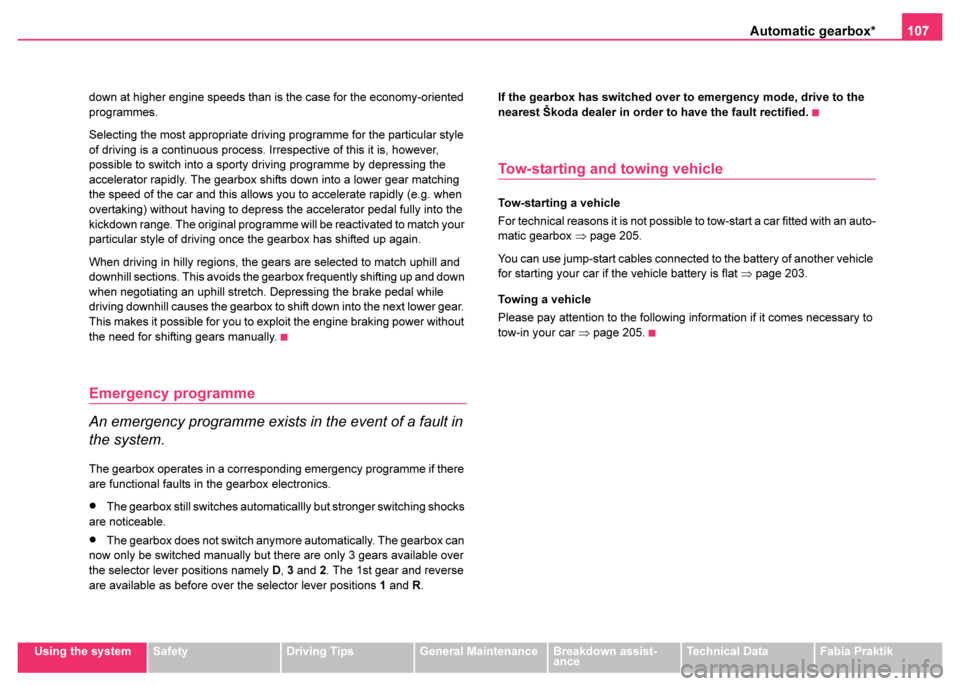
Automatic gearbox*107
Using the systemSafetyDriving TipsGeneral MaintenanceBreakdown assist-
anceTechnical DataFabia Praktik
down at higher engine speeds than is the case for the economy-oriented
programmes.
Selecting the most appropriate driving programme for the particular style
of driving is a continuous process. Irrespective of this it is, however,
possible to switch into a sporty driving programme by depressing the
accelerator rapidly. The gearbox shifts down into a lower gear matching
the speed of the car and this allows you to accelerate rapidly (e.g. when
overtaking) without having to depress the accelerator pedal fully into the
kickdown range. The original programme will be reactivated to match your
particular style of driving once the gearbox has shifted up again.
When driving in hilly regions, the gears are selected to match uphill and
downhill sections. This avoids the gearbox frequently shifting up and down
when negotiating an uphill stretch. Depressing the brake pedal while
driving downhill causes the gearbox to shift down into the next lower gear.
This makes it possible for you to exploit the engine braking power without
the need for shifting gears manually.
Emergency programme
An emergency programme exists in the event of a fault in
the system.
The gearbox operates in a corresponding emergency programme if there
are functional faults in the gearbox electronics.
•The gearbox still switches automaticallly but stronger switching shocks
are noticeable.
•The gearbox does not switch anymore automatically. The gearbox can
now only be switched manually but there are only 3 gears available over
the selector lever positions namely D, 3 and 2. The 1st gear and reverse
are available as before over the selector lever positions 1 and R. If the gearbox has switched over to emergency mode, drive to the
nearest Škoda dealer in order to have the fault rectified.
Tow-starting and towing vehicle
Tow-starting a vehicle
For technical reasons it is not possible to tow-start a car fitted with an auto-
matic gearbox
⇒page 205.
You can use jump-start cables connected to the battery of another vehicle
for starting your car if the vehicle battery is flat ⇒page 203.
Towing a vehicle
Please pay attention to the following information if it comes necessary to
tow-in your car ⇒page 205.
Page 146 of 233
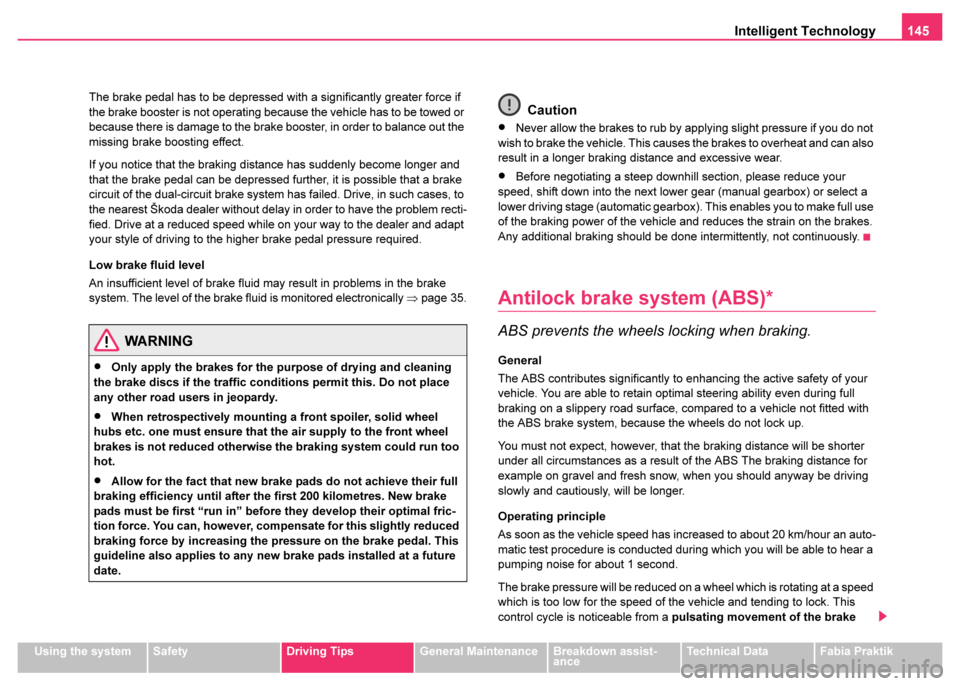
Intelligent Technology145
Using the systemSafetyDriving TipsGeneral MaintenanceBreakdown assist-
anceTechnical DataFabia Praktik
The brake pedal has to be depressed with a significantly greater force if
the brake booster is not operating because the vehicle has to be towed or
because there is damage to the brake booster, in order to balance out the
missing brake boosting effect.
If you notice that the braking distance has suddenly become longer and
that the brake pedal can be depressed further, it is possible that a brake
circuit of the dual-circuit brake system has failed. Drive, in such cases, to
the nearest Škoda dealer without delay in order to have the problem recti-
fied. Drive at a reduced speed while on your way to the dealer and adapt
your style of driving to the higher brake pedal pressure required.
Low brake fluid level
An insufficient level of brake fluid may result in problems in the brake
system. The level of the brake fluid is monitored electronically
⇒page 35.
Caution
•Never allow the brakes to rub by applying slight pressure if you do not
wish to brake the vehicle. This causes the brakes to overheat and can also
result in a longer braking distance and excessive wear.
•Before negotiating a steep downhill section, please reduce your
speed, shift down into the next lower gear (manual gearbox) or select a
lower driving stage (automatic gearbox). This enables you to make full use
of the braking power of the vehicle and reduces the strain on the brakes.
Any additional braking should be done intermittently, not continuously.
Antilock brake system (ABS)*
ABS prevents the wheels locking when braking.
General
The ABS contributes significantly to enhancing the active safety of your
vehicle. You are able to retain optimal steering ability even during full
braking on a slippery road surface, compared to a vehicle not fitted with
the ABS brake system, because the wheels do not lock up.
You must not expect, however, that the braking distance will be shorter
under all circumstances as a result of the ABS The braking distance for
example on gravel and fresh snow, when you should anyway be driving
slowly and cautiously, will be longer.
Operating principle
As soon as the vehicle speed has increased to about 20 km/hour an auto-
matic test procedure is conducted during which you will be able to hear a
pumping noise for about 1 second.
The brake pressure will be reduced on a wheel which is rotating at a speed
which is too low for the speed of the vehicle and tending to lock. This
control cycle is noticeable from a pulsating movement of the brake
WARNING
•Only apply the brakes for the purpose of drying and cleaning
the brake discs if the traffic conditions permit this. Do not place
any other road users in jeopardy.
•When retrospectively mounting a front spoiler, solid wheel
hubs etc. one must ensure that the air supply to the front wheel
brakes is not reduced otherwise the braking system could run too
hot.
•Allow for the fact that new brake pads do not achieve their full
braking efficiency until after the first 200 kilometres. New brake
pads must be first “run in” before they develop their optimal fric-
tion force. You can, however, compensate for this slightly reduced
braking force by increasing the pressure on the brake pedal. This
guideline also applies to any new brake pads installed at a future
date.
Page 148 of 233
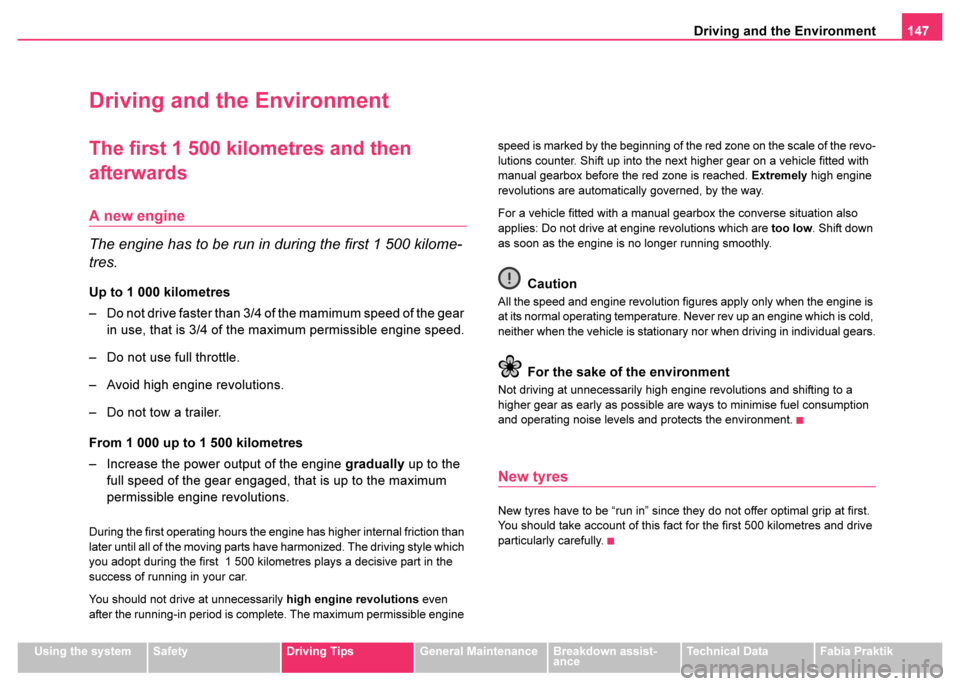
Driving and the Environment147
Using the systemSafetyDriving TipsGeneral MaintenanceBreakdown assist-
anceTechnical DataFabia Praktik
Driving and the Environment
The first 1 500 kilometres and then
afterwards
A new engine
The engine has to be run in during the first 1 500 kilome-
tres.
Up to 1 000 kilometres
– Do not drive faster than 3/4 of the mamimum speed of the gear
in use, that is 3/ 4 of the maximum permissib le engine speed.
– Do not use full throttle.
– Avoid high engine revolutions.
– Do not tow a trailer.
From 1 000 up to 1 500 kilometres
– Increase the power output of the engine gradually up to the
full speed of the gear engaged, that is up to the maximum
permissible engine revolutions.
During the first operating hours the engine has higher internal friction than
later until all of the moving parts have harmonized. The driving style which
you adopt during the first 1 500 kilometres plays a decisive part in the
success of running in your car.
You should not drive at unnecessarily high engine revolutions even
after the running-in period is complete. The maximum permissible engine speed is marked by the beginning of the red zone on the scale of the revo-
lutions counter. Shift up into the next higher gear on a vehicle fitted with
manual gearbox before the red zone is reached.
Extremely high engine
revolutions are automatically governed, by the way.
For a vehicle fitted with a manual gearbox the converse situation also
applies: Do not drive at engine revolutions which are too low. Shift down
as soon as the engine is no longer running smoothly.
Caution
All the speed and engine revolution figures apply only when the engine is
at its normal operating temperature. Never rev up an engine which is cold,
neither when the vehicle is stationary nor when driving in individual gears.
For the sake of the environment
Not driving at unnecessarily high engine revolutions and shifting to a
higher gear as early as possible are ways to minimise fuel consumption
and operating noise levels and protects the environment.
New tyres
New tyres have to be “run in” since they do not offer optimal grip at first.
You should take account of this fact for the first 500 kilometres and drive
particularly carefully.